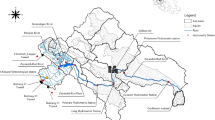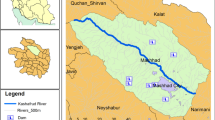Abstract
The water shortage crisis that is sweeping the world today has posed serious harm and threat to people around the world. Meanwhile, Iran is one of the water-scarce countries due to its location in arid and semi-arid belt and fluctuations in rainfall. The pervasive nature of water and the existence of numerous human and environmental factors affecting its reliability have greatly complicated the interactions between the human-environment dimensions. Therefore, there is a need to merge knowledge from the social and natural sciences. In this regard, this study aimed to provide a water security conceptual model in the Neishabour plain watershed by combining a framework for Human - Environmental System (HES) interactions and System Dynamic (SD) aproach in relation to the concept of water security. For this purpose, a qualitative research method consists of combined an initial conceptual model with a Causal Loop Diagram (CLD) obtained from interviews with the key research community was used to present relationships and develop a conceptual model of water security. The results show that understanding the hierarchical levels of environmental awareness and ultimately learning and practice based on key components and interactions identified by the HES framework, facilitates the analysis of system complexity. In this regard, if water resources management organization pay attention to the factors affecting the concept of water security, by using and implementing the conceptual model presented in this study, it is possible to improve the compatibility capacity and develop effective operational plans with correct and timely pathology to achieved more stable and comprehensive water resources management in the watersheds.


Similar content being viewed by others
Data Availability
Raw data were generated at University of Tehran. We confirm that the data, models, or methodology used in the research are proprietary, and derived data supporting the findings of this study are available from the first author on request.
References
Banson KE, Nguyen NC, Bosch OJH (2016) Using System Archetypes to identify drivers and barriers for sustainable agriculture in Africa: a Case Study in Ghana. Syst Res Behav Sci 33:79–99. doi:https://doi.org/10.1002/sres.2300
Barati AA, Azadi H, Scheffran J (2019) A system dynamics model of smart groundwater governance. Agric Water Manage 221:502–518. https://doi.org/10.1016/j.agwat.2019.03.047
Barlas Y (1996) Formal aspects ofmodel validity and validation in system dynamics. Syst Dyn Rev 12:183–210. https://doi.org/10.1002/(SICI)1099-1727(199623)12:33.0.CO;2-4
Beall A, Fiedler F, Boll J, Cosens B (2011) Sustainable water resource management and participatory system dynamics. Case study: developing the Palouse Basin participatory model. Sustainability 3(5):720–742. https://doi.org/10.3390/su3050720
Beall A, Zeoli L (2008) Participatory modeling of endangered wildlife systems: simulating the sage-grouse and land use in Central Washington. https://doi.org/10.1016/j.ecolecon.2008.08.019. Ecol Econ
Bano R, Khiadani M, Nyam YS (2022) System Archetypes underlying Formal-Informal Urban Water Supply Dynamics. Water Resour Manage 36:4995–5010. https://doi.org/10.1007/s11269-022-03288-w
Cain J, Moriarty P, Lynam T (2001) Designing integrated models for the participatory formulation of water management strategies. Center of Ecology and Hydrology, Bailrigg
Castillo RM, Wilhelm FM, Machado K (2019) A CLEWS Nexus modeling approach to assess water security trajectories and infrastructure needs in Latin America and the Caribbean. Inter-American Development Bank. Water and Sanitation Division. 63P
Dau QV, Kuntiyawichai K, Adeloye AJ (2021) Future changes in water availability due to Climate Change Projections for Huong Basin, Vietnam. Environ Process 8:77–98. https://doi.org/10.1007/s40710-020-00475-y
Empinotti VL, Buddsb J, Aversa M (2018) Governance and water security: the role of the water institutionalframework in the 2013–15 water crisis in Sao Paulo. Brazil. Geoforum
European Commission (2015) Science for environment policy. Future brief: innovation in theEuropean water sector
Ford FA (2010) Modeling the environment: an introduction to system dynamics models of environmental systems. Island press. https://doi.org/10.1002/sdr.272
Grey D, Sadoff CW (2007) Sink or swim? Water security for growth and development. Water Policy 9:545–571
Gu J, Sun S, Wang Y et al (2021) Sociohydrology: an effective way to reveal the coupled evolution of Human and Water Systems. Water Resour Manage 35:4995–5010. https://doi.org/10.1007/s11269-021-02984-3
Gunda. T, Hess D, Hornberger GM, Worland S (2019) Water security in practice: the quantity-quality-society nexus. J Water Secur 6:1–6
Hossain MS, Dearing JA, Eigenbrod F, Jhonson FA (2017) Operationalizing safe operating space for regional socialecological systems. Sci Total Environ. https://doi.org/10.1016/j.scitotenv.2017.01.095
Hossain MS, Ramirez JA, Haisch T, Speranza CI, Martius O, Mayer H, Keiler M (2020a) A coupled human and landscape conceptual model of risk and resilience in Swiss Alpine communities. Sci Total Environ 730. https://doi.org/10.1016/j.scitotenv.2020.138322
Hossain MS, Ramirez J, Szabo S et al (2020b) Participatory modelling for conceptualizing social-ecological system dynamics in the Bangladesh delta. Reg Environ Change 20(28). https://doi.org/10.1007/s10113-020-01599-5
Jakeman AJ, Letcher RA, Norton JP (2006) Ten iterative steps in development and evaluation of environmental models. Environ Model Softw 21:602–614. https://doi.org/10.1016/j.envsoft.2006.01.004
Khan S, Yufeng L, Ahmad A (2009) Analysing complex behaviour of hydrological systems through a system dynamics approach. Environ Model Softw 24(12):1363–1372
Lankford B, Bakker K, Zeitoun M, Conway D (eds) (eds) 2013. Water Security, Principles, Perspectives and Practices.Routledge, Oxon and New York
Leenhardt P, Stelzenmüller V, Pascal N, Probst WN, Aubanel A, Bambridge T, Mahé C, Clua A, Féral F, Quinquis B, Salvat B, Claudet J (2017) Exploring social-ecological dynamics of a coral reef resource system using participatory modeling and empirical data. Mar Policy 78:90–97. https://doi.org/10.1016/j.marpol.2017.01.014
Li W, Ali SH, Zhang Q Property right and grassland degradation: a study of the Xilingol Pasture, Inner Mongolia, China. Journal of Environmental Management, 85(2), 61–70., Li Y, Kappas M, Li Y (2007) 2018. Exploring the coastal urban resilience and transformation of coupled human-environment systems. Journal of Cleaner Production, 195: 1505–1511
Li Y, Kappas M, Li Y (2018) Exploring the coastal urban resilience and transformation of coupledhuman-environment systems. J Clean Prod 195:1505–1511
Meadows DL, Behrens IIIWW, Meadows DH, Naill RF, Randers J, Zahn EKO (2008) Dynamics of growth in a finite world. Cambridge, Massachusetts: Wright-Allen Press, Inc modelling: The Baixo Guadiana experience Ecological Economics 68(4): 965–978
Mirchi A, Madani K, Watkins D, Ahmad S (2012) Synthesis of System Dynamics Tools for holistic conceptualization of Water Resources problems. Water Resour Manag 26:2421–2442. doi:https://doi.org/10.1007/s11269-012-0024-2
OECD (2013) Water security for better lives. OECD Studies on Water. Organisation for Economic Co-operation and Development, Paris
Pahl-Wostl C (2015) Water Governance in the Face of Global Change: from understanding to Transformation. Institute for Environmental Systems Research. University of Osnabruk, Osnabruk, Germany
Ravar Z, Zahraie B, Sharifinejad A, Gozini H, Samannaz Jafari (2020) System dynamics modeling for assessment of water–food–energy resources security and nexus in Gavkhuni basin in Iran, Ecological indicators. 108. https://doi.org/10.1016/j.ecolind.2019.105682
Ritzema H, Froebrich J, Raju R, ch S, Kselik R (2010) Using participatory modelling to compensate for data scarcity in environmental planning: a case study from India. Environ Model Softw 25:1450–1458. https://doi.org/10.1016/j.envsoft.2010.03.010
Scholz RW (2011) Environmental literacy in Science and Society: from knowledge to decisions. Cambridge University Press, Cambridge, UK
Simms, Harris L, Joe N, Bakker K (2016) Navigating the tensions in collaborative watershed governance: Watergovernance and indigenous communities in British Columbia, Canada. J Geoforume 73:6–16
United Nations University (2013) Water security & the global water agenda. A UN-Water analytical brief. United Nations Institute for Water Environment and Health, United Nations Economic and Social Commission for Asia and the Pacific, Canad
Videira N, Antunes P, Santos R (2009) Scoping river basin management issues with participatory modelling: the Baixo Guad iana experience. Ecol Econ 68(4):965–978. https://doi.org/10.1016/j.ecolecon.2008.11.008
World Bank (2015) A water-secure world for all. Water for development: responding to the challenges. Conference Edition. World Bank, Washington DC
Yazdanparast M, Ghorbani M, Salajegheh A, Kerachian R (2021) Development of the Framework of Human-Environment System (HES) Interactions in the Concept of Water Security (Study Area: Neyshabour Plain). 10th International Conference on Rainwater Catchment System, ICRWC 2021. 24& 25 November. Iran
Zare F, Elsawah S, Bagheri A, Nabavi E, Jakeman AJ (2019) Improved integrated water resource modelling by combining DPSIR and system dynamics conceptual modelling techniques. J Environ Manage 246:27–41. https://doi.org/10.1016/j.jenvman.2019.05.033
Zeraati Neyshabouri S, Pourreza Bilondi M, Khashei Siuki A, Shahidi A (2020) Comprison of fuzzy Possibilistic regression and fuzzy least square regression models to Estimate Groundwater Level of Neyshabour Aquifer. Irrig Sci Eng 43(1):131–143. doi: https://doi.org/10.22055/jise.2018.23275.1652
Zhou F, Zhang W, Su W, Peng H, Zhou S (2021) Spatial differentiation and driving mechanism of rural water security in typical “engineering water depletion” of karst mountainous area—A lesson of Guizhou, China. J of Science of The Total Environment 793:148387. https://doi.org/10.1016/j.scitotenv.2021.148387
Funding
This study received no findings from any organizations.
Author information
Authors and Affiliations
Contributions
Maryam Yazdanparast: Conceptualization, Methodology, Software, Writing - Original draft, Visualization. Mehdi Ghorbani: Supervision, Conceptualization, Reviewing and Editing, Validation. Ali Salajegheh: Reviewing and Editing, Validation. Reza Kerachian: Supervision, Conceptualization, Reviewing and Editing, Validation.
Corresponding author
Ethics declarations
Ethical Approval
The authors declare that this submission follows the policies as outlined in the Guide for Authors and in the Ethical Statement.
Consent to Participate
All authors are agree to be a participant in this study and are aware of what this study involves.
Consent to Publish
All authors are agree to Publish this paper in the Journal of Water Resources Management.
Competing Interests
The authors declare that they have no known competing financial interests or personal relationships that could have appeared to influence the work reported in this paper.
Additional information
Publisher’s Note
Springer Nature remains neutral with regard to jurisdictional claims in published maps and institutional affiliations.
Rights and permissions
Springer Nature or its licensor (e.g. a society or other partner) holds exclusive rights to this article under a publishing agreement with the author(s) or other rightsholder(s); author self-archiving of the accepted manuscript version of this article is solely governed by the terms of such publishing agreement and applicable law.
About this article
Cite this article
Yazdanparast, M., Ghorbani, M., Salajegheh, A. et al. Development of a Water Security Conceptual Model by Combining Human-Environmental System (HES) and System Dynamic Approach. Water Resour Manage 37, 1695–1709 (2023). https://doi.org/10.1007/s11269-023-03449-5
Received:
Accepted:
Published:
Issue Date:
DOI: https://doi.org/10.1007/s11269-023-03449-5




